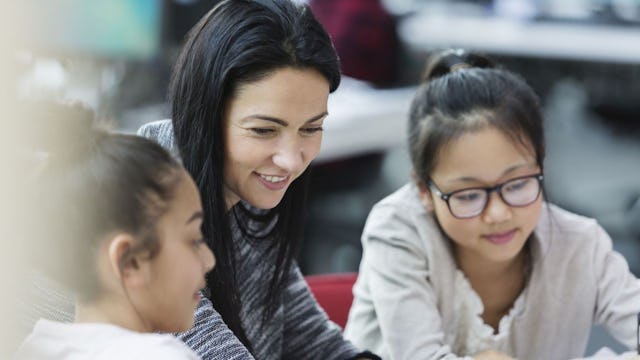Schools Need To Focus On This Instead Of Grades

My son came home from school beaming, a piece of paper clutched in his hands. “What is that, buddy?” I asked him, crouching down to his eye-level. He squealed, “I got an award!”
He had been working very hard at school to use his words to state his needs and respond to situations, and his award showed that his hard work had paid off. He had been called down to the principal’s office over the speaker, and his entire class knew why. He was earning a “Do the Right Thing Award.”
Parents everywhere can testify that connection in the form of positive reinforcement can do wonders for all children. And we’re not talking about every child getting a ribbon or a gold star. In fact, acknowledgement and connection are really damn simple.
In this video from Edutopia, created by the George Lucas Educational Foundation (yes, THE George Lucas), we can watch students’ reactions to school staff who take a few moments to acknowledge and uplift students with simple acts such as eye contact, encouraging words, and high-fives.
How are these so powerful? It comes down to science.
Dr. Pamela Cantor, seen in the video, shares, “When children have experiences of closeness and consistency and trust, oxytocin is released. And oxytocin has many, many positive effects on the development of the brain.”
Oxytocin is a hormone that serves many purposes, including acting as an anti-depressant and increasing attachment between humans. It’s also called the “love hormone” that simulates those warm-and-fuzzy feelings people can have toward one another.
The video goes on to demonstrate that if teachers and other school staff members take the time to establish positive, long-term relationships with students, the students are more likely to be successful academically. Students feel safe, included, and prioritized.
In essence, students who feel connected to educators are primed to learn. Relationships matter, and they not only matter, but they are downright magical when it comes to children’s educations.
I witnessed this for myself when I taught college English for nine years. Like the students in the video, I had students who struggled with everyday life. One student’s mom was gravely ill. Another student was a single mom of two kids, and she was working two jobs while attending college classes at night. These are just two of the many examples.
I took the time, as a teacher, to prioritize my students as people and make connections with them. I stayed after class or arrived early to make sure I was in the classroom to greet the students as they walked in. I helped a student register with disability support services so he could better learn. I assisted other students in signing up for counseling for their struggles with anxiety, depression, and participating in unhealthy relationships.
My students knew that I cared more about their well-being than the grade I wrote at the top of their essays. And because they knew I cared, they showed up to class (mostly on time), they participated, and they turned in their work which reflected our meetings in which I provided suggestions on how to improve on their writing.
I noticed that the students I connected with the most typically had better grades. It wasn’t because I favored those students, as I prided myself on being a fair teacher with strict policies. The difference was these students were actively engaged in their education, and it showed in the work they produced.
So when my own son came home with his certificate, I was in all-out celebratory mode. I know that success doesn’t come easily to all kids. But I do know that there were some kind, encouraging individuals who were pushing my son to be his best, including his principal, teachers, bus driver, and speech therapist.
The Beatles song “All You Need is Love” comes to mind. (You’re welcome for getting it stuck in your head for the day.) Connection is really so simple, yet it’s incredibly far-reaching and powerful.
Unfortunately, our teachers are under a lot of pressure and constraints. My teacher friends tell me that not only are their plates full, but they carry lots of plates at one time, much like a waiter who has hefty trays in each hand. They are overworked, underpaid, and often under-appreciated. Yet the work they do for our children is critically important.
But what the video shows us is that taking just a few seconds per student each day, to offer a word of encouragement or a high five and eye contact, can make the rest of the day productive, even enjoyable. And for some children, the connection they receive at school from a trusted adult may be the only connection they receive at all.
What if each morning students were greeted, as they were in the video? What dramatic changes would we see? Would kids more readily rise to academic success, having their basic needs met first rather than treated as an afterthought?
I think we all know the answer.